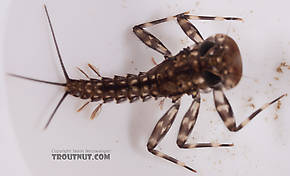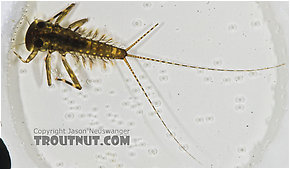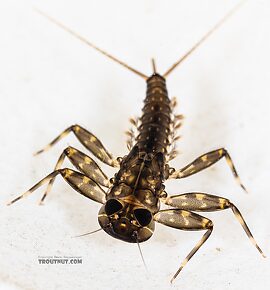Blog & Latest Updates
Fly Fishing Articles
Insects by Common Name


Mayfly Species Heptagenia pulla (Golden Dun)
Taxonomic Navigation -?-
Kingdom
Animalia (Animals)
» Phylum
Arthropoda (Arthropods)
» Class
Insecta (Insects)
» Order
Ephemeroptera (Mayflies)
» Genus
Heptagenia
» Species pulla (Golden Dun)
Common Names
| Match | Common Name |
| Golden Dun | |
| March Brown |
Where & When
There are conflicting accounts of the emergence dates for this species. The Leonards in Hatches II give June 2nd to August 4th as the dates for emergence in Michigan, while Caucci and Nastasi in Hatches II say it hatches from August through October. Knopp and Cormier say it hatches from mid-May through August. I don't know who is correct, but I have collected near-mature nymphs in June in northern Wisconsin.
Nymph Biology
Current Speed: Slow to medium; sometimes riffles
Substrate: Detritus (Detritus: Small, loose pieces of decaying organic matter underwater.)
Pictures of 3 Mayfly Specimens in the Species Heptagenia pulla:
Heptagenia pulla (Golden Dun) Mayfly Nymph View 8 PicturesLike most Alaskan mayflies, this one is tricky to identify to the species level. See the discussion section for an informative chat about this one's ID. The current leaning is to call it a fairly immature Heptagenia pulla nymph, but a case has been made for Heptagenia elegantula as well.
View 8 PicturesLike most Alaskan mayflies, this one is tricky to identify to the species level. See the discussion section for an informative chat about this one's ID. The current leaning is to call it a fairly immature Heptagenia pulla nymph, but a case has been made for Heptagenia elegantula as well.
 View 8 PicturesLike most Alaskan mayflies, this one is tricky to identify to the species level. See the discussion section for an informative chat about this one's ID. The current leaning is to call it a fairly immature Heptagenia pulla nymph, but a case has been made for Heptagenia elegantula as well.
View 8 PicturesLike most Alaskan mayflies, this one is tricky to identify to the species level. See the discussion section for an informative chat about this one's ID. The current leaning is to call it a fairly immature Heptagenia pulla nymph, but a case has been made for Heptagenia elegantula as well.Heptagenia pulla (Golden Dun) Mayfly Nymph View 5 PicturesI used a microscope to positively identify this nymph as Heptagenia pulla. (Edit six years later: I wish I had explained why I was positive about this. It may have been based on color patterns in an angling text, which are not especially reliable for species ID anymore.)
View 5 PicturesI used a microscope to positively identify this nymph as Heptagenia pulla. (Edit six years later: I wish I had explained why I was positive about this. It may have been based on color patterns in an angling text, which are not especially reliable for species ID anymore.)
 View 5 PicturesI used a microscope to positively identify this nymph as Heptagenia pulla. (Edit six years later: I wish I had explained why I was positive about this. It may have been based on color patterns in an angling text, which are not especially reliable for species ID anymore.)
View 5 PicturesI used a microscope to positively identify this nymph as Heptagenia pulla. (Edit six years later: I wish I had explained why I was positive about this. It may have been based on color patterns in an angling text, which are not especially reliable for species ID anymore.)Collected June 5, 2005 from the Long Lake Branch of the White River in Wisconsin
Added to Troutnut.com by Troutnut on May 25, 2006
Added to Troutnut.com by Troutnut on May 25, 2006
Heptagenia pulla (Golden Dun) Mayfly Nymph View 11 PicturesThis specimen is interesting because Heptagenia pulla has not been reported from Washington or neighboring states (Saskatchewan is the closest), yet the distinctive key characteristics are clear.
View 11 PicturesThis specimen is interesting because Heptagenia pulla has not been reported from Washington or neighboring states (Saskatchewan is the closest), yet the distinctive key characteristics are clear.
It keys to the genus Heptagenia because the tarsal claw (Tarsal claw: The claws at the tip of the tarsus, on an insect's "foot.") has a single basal (Basal: close to the base; root or beginning) tooth, and the gills on segment 7 have fibrils.
For the species key:
1. The left mandible (Mandible: The paired jaws of an insect which are used for grabbing food, located immediately behind the labrum.) is planate (fairly straight-edged) whereas the right mandible (Mandible: The paired jaws of an insect which are used for grabbing food, located immediately behind the labrum.) is angulate (has one sharp turn on the edge).
2. The labrum (Labrum: The platelike structure forming the roof of the mouth of insects; the upper lip.) is much wider than long.
3. There's a thin light-colored streak lateral (Lateral: To the side.) to the eye on the head.
 View 11 PicturesThis specimen is interesting because Heptagenia pulla has not been reported from Washington or neighboring states (Saskatchewan is the closest), yet the distinctive key characteristics are clear.
View 11 PicturesThis specimen is interesting because Heptagenia pulla has not been reported from Washington or neighboring states (Saskatchewan is the closest), yet the distinctive key characteristics are clear.It keys to the genus Heptagenia because the tarsal claw (Tarsal claw: The claws at the tip of the tarsus, on an insect's "foot.") has a single basal (Basal: close to the base; root or beginning) tooth, and the gills on segment 7 have fibrils.
For the species key:
1. The left mandible (Mandible: The paired jaws of an insect which are used for grabbing food, located immediately behind the labrum.) is planate (fairly straight-edged) whereas the right mandible (Mandible: The paired jaws of an insect which are used for grabbing food, located immediately behind the labrum.) is angulate (has one sharp turn on the edge).
2. The labrum (Labrum: The platelike structure forming the roof of the mouth of insects; the upper lip.) is much wider than long.
3. There's a thin light-colored streak lateral (Lateral: To the side.) to the eye on the head.
Collected April 9, 2021 from the Yakima River in Washington
Added to Troutnut.com by Troutnut on April 12, 2021
Added to Troutnut.com by Troutnut on April 12, 2021
Your Thoughts On Heptagenia pulla:
Top 10 Fly Hatches
Top Gift Shop Designs
Eat mayflies.
Top Insect Specimens
Miscellaneous Sites
Troutnut.com is copyright © 2004-2024 Jason
Neuswanger (email Jason). See my FAQ for information about use of my images.
 privacy policy
privacy policy
